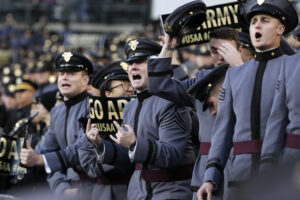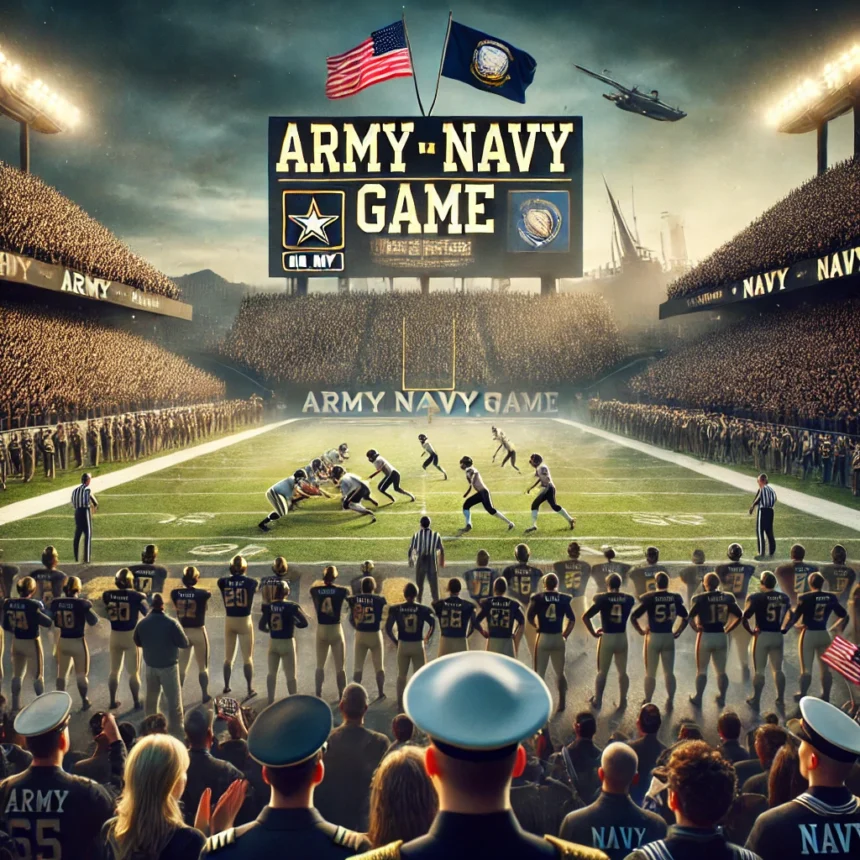Introduction
The Army-Navy Game is more than just a football match; it celebrates it’s tradition, rivalry, and military pride. Held annually, this storied clash between the U.S. Military Academy (Army) and the U.S. Naval Academy (Navy) is a highlight of the college football season. Known for its pageantry, intensity, and deep-rooted significance, the Army-Navy Game encapsulates the essence of college football and military camaraderie. In this article, we delve into the origins, history, and modern-day impact of this iconic game, exploring why it remains one of the most anticipated events in sports.
The Origins of the Army-Navy Game
The Army-Navy Game traces its origins back to 1890 when the first match was played at West Point. At that time, the Army and Navy were emerging as prominent institutions of military education, and their football teams were keen to establish dominance on the field. The inaugural game, held on November 29, 1890, ended in a 24-0 victory for Navy. This match began what would become one of the longest-standing rivalries in American sports.
The game was played in various locations in the early years, often rotating between West Point and Annapolis. The tradition of holding the game in Philadelphia, a neutral site, began in 1930. This decision ensured neither team had a home-field advantage, emphasizing the game’s significance as an actual contest of skill and spirit.

Historical Highlights
Throughout its history, the Army-Navy Game has produced numerous memorable moments. These highlights not only showcase the skill and determination of the players but also reflect the broader cultural and historical context of the times.
One of the most iconic moments came in 1944, during World War II when the game was played at a time of great national significance. The match was played amid the backdrop of the war, with both teams fielding players who would soon serve in combat. Navy won that game, but the significance of the match extended far beyond the scoreboard, symbolizing unity and patriotism during a challenging period.
Another memorable moment occurred in 1963, when President John F. Kennedy attended the game. His presence underscored the rivalry’s national importance and the game’s role in fostering a sense of national pride and unity.
In recent years, the 2016 game has stood out for its dramatic finish. Navy, led by quarterback Will Worth, secured a last-minute victory over Army with a thrilling touchdown run. This game exemplified the high competition and excitement that defines the Army-Navy Game.
The Rivalry Explained
The rivalry between Army and Navy is fueled by more than just athletic competition. It embodies a more profound sense of tradition, pride, and mutual respect between the academies. The roots of this rivalry are deeply intertwined with the history and missions of the institutions involved.
The U.S. Military Academy, established in 1802, and the U.S. Naval Academy, founded in 1845, have long been institutions of excellence and leadership. The rivalry reflects not only their competitive spirit but also their commitment to service and honour. Each year, the Army-Navy Game serves as a battleground where these values are tested, with both teams striving to uphold their respective traditions and legacies.
The rivalry also extends beyond the football field. It is reflected in various aspects of academy life, including academics, athletics, and military training. This competitive spirit is a driving force that pushes both academies to excel and maintain their high standards.
The Impact on Players and Fans
For players, the Army-Navy Game represents the pinnacle of their college football careers. It is a chance to compete in one of the most prestigious and high-stakes games in college sports. The game’s significance is reflected in the intense preparation and focus that players bring to the field. The experience of participating in the Army-Navy Game is often cited as one of the most memorable and rewarding moments of a player’s career.
For fans, the Army-Navy Game is more than just a football game; it is a celebration of tradition and loyalty. Fans from both sides turn out in droves to support their teams, creating an electric atmosphere unmatched in college sports. The game’s traditions, such as the March-On, where both teams march onto the field in full military regalia, add to the spectacle and pageantry.
The rivalry also profoundly impacts alumni and military personnel. For many, attending the Army-Navy Game is a cherished tradition connecting them to their alma mater and service. It serves as a reminder of the shared values and experiences that unite them with their fellow alums and military colleagues.

Modern-Day Significance
While the Army-Navy Game has deep historical roots, its relevance in the modern era remains strong. The game continues to capture fans’ imaginations and maintains its status as a significant cultural and sporting event.
The Army-Navy Game has embraced modern broadcasting and digital media in recent years, expanding its reach and accessibility. The game is broadcast nationally, attracting millions of viewers and showcasing the traditions and excitement of the match to a global audience. Social media has also amplified the game’s impact, allowing fans to engage with the rivalry and share their experiences in real-time.
The continued success and popularity of the Army Navy Game highlight its enduring appeal and the timeless nature of its traditions. Despite the changes in college football and the broader sports landscape, the Army-Navy Game remains a symbol of excellence, honour, and camaraderie.
Key Players and Memorable Performances
Over the years, the Army-Navy Game has featured numerous standout players and memorable performances. These individuals have left a lasting impact on the game and have become legends in their own right.
One notable player is Roger Staubach, a Navy quarterback who played in the 1960s. Staubach’s performance in the 1963 Army Navy Game was instrumental in the Navy’s victory, and he went on to have a successful career in the NFL. His leadership and skill on the field made him a standout figure in the rivalry.
Another key player is Army’s Doc Blanchard, who played in the 1940s. Blanchard, also known as “Mr. Inside,” was a dominant force in college football and played a crucial role in the Army’s victories during his time. His contributions to the game have solidified his place in the history of the Army-Navy rivalry.
Players like Navy’s Keenan Reynolds have made their mark on the game in recent years. Reynolds, a standout quarterback, set numerous records and led Navy to victory in several key matchups. His performances exemplify the high level of talent and determination that defines the Army-Navy Game.

The Game’s Influence on College Football
The Army-Navy Game has significantly influenced college football, both in terms of its traditions and its impact on the sport. The game’s unique traditions, such as the pre-game rituals and the ceremonial presentation of the trophy, have become iconic elements of college football culture.
The rivalry also serves as a showcase for the skills and talents of college football players. Many athletes in the Army-Navy Game have had successful careers in the NFL and other professional leagues. The game’s emphasis on discipline, teamwork, and excellence reflects the core values of college football and the broader sports community.
Moreover, the Army-Navy Game has contributed to the growth and popularity of college football. Its high-profile matchups and dramatic finishes have captured the attention of fans and media alike, helping to elevate the sport’s profile and attract new audiences.
FAQs
Q1: When is the Army-Navy Game held each year?
The Army-Navy Game is traditionally played on the second Saturday of December. This timing makes it a prominent feature in the college football season and ensures it receives national attention.
Q2: How many times has the Army won the Army-Navy Game?
As of the most recent season, Army has won the Army-Navy Game X times. The number of victories can vary yearly, so checking the latest statistics for the most current record is advisable.
Q3: What are some notable traditions associated with the Army-Navy Game?
The Army-Navy Game is known for its unique traditions, including the March-On, where both teams march onto the field in full military regalia and the presentation of the Commander-in-Chief’s Trophy. These traditions add to the pageantry and significance of the game.
Q4: How can I watch the Army-Navy Game?
The Army-Navy Game is typically broadcast on major sports networks such as CBS. For the most accurate and up-to-date broadcast information, check local listings or the official websites of the participating academies.
Conclusion
The Army-Navy Game remains a cherished tradition in college football, representing more than just a rivalry. Its rich history, memorable moments, and ongoing significance continue to make it a highlight of the football season. As we look forward to each year’s game, we celebrate the values and spirit that define this iconic matchup, honoring the tradition of excellence and camaraderie that the Army-Navy Game embodies.





